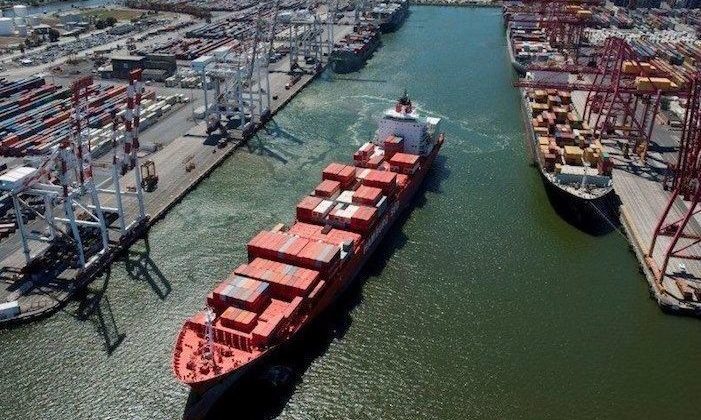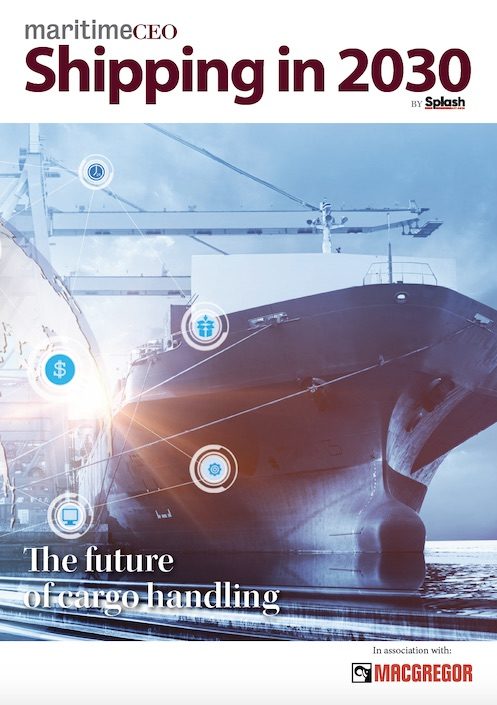Cargo flow in 2030

Revolution or evolution? What will the business of shipping and ports look like 10 years from now? The next chapter in our week-long look at the future of the industry, published in association with MacGregor.
How will the business of cargo flow and handling change over the next 10 years? It’s a question Maritime CEO has posed to hundreds of shipping executives in recent months. Some have BladeRunner-esque visions of the ship/port interface; others are more cautious about the speed of change.
The twin focus on market share and economies of scale has gone
For Graham Porter, the famous co-founder of Seaspan and now head of Tiger Group Investments, the biggest change coming is in automatic trucking, likely in combination with battery propulsion.
“This will redefine the logistics of the world,” Porter argues in conversation with Maritime CEO. “Efficiencies will improve dramatically, essentially highway trains will come about, with cargo moving 24 hours a day as there will be no limiting human driver and mandatory rest breaks. It will all be optimised to avoid rush hours. This could potentially redefine which ports are winners, displacing some of the old names.”
Phil Curran, vice president at G2 Ocean, says changes in cargo handling methods over the next 10 years will be driven by technology improvements.
“As technology improves and becomes less expensive and more accessible, we are expecting many opportunities in the breakbulk sector for improved, efficient automation, especially in operations onshore,” Curran says.
As an example, Curran expects shipping companies to use Radio-Frequency Identification (RFID) technology increasingly to monitor cargo from the first to the last mile.
“Tagging with RFIDs will be commonplace and will not only improve the visibility of cargo transport along a shipment journey but also help to improve our supply chain management,” Curran says.
Coordinated improvements
Kris Kosmala, a cargo handling expert and regular Maritime CEO columnist, says it is vital for the industry as a whole to work together to drive efficiencies over the coming decade.
“Value is created out of coordinated improvements across all port-vessel and port-cargo touch points,” Kosmala reminds readers.
Value is created out of coordinated improvements across all port-vessel and port-cargo touch points
Looking at specific touch points reveals where the improvements and changes will be happening over the next 10 years. In the physical port-vessel interface area Kosmala reckons we will see progressive deployment of vessel mooring solutions such as smart bollards and smart quay walls based on sensors and movement suppression technology between the bollard and the vessel.
But the physical aspect of mooring systems does not create sufficient value nor competitive differentiation. There is a need, Kosmala reckons, for predictive and optimisation software to be deployed above the physical interface that would aid terminal mooring crew in both tactical planning (where and how to position vessel at the quay in advance of the arrival/departure), as well as operational decisions on securing/releasing the vessel on the day of its actual arrival/departure in port.
Predictive maintenance
“The next 10 years will bring increasing sophistication of sensors and also sophistication of software capable of reading data from the sensors and predicting equipment servicing needs and optimising repairs and maintenance on the shore and ship equipment,” Kosmala suggests.
John Carnall, senior vice president in MacGregor’s global services division, agrees wholeheartedly with Kosmala on this point. Carnall can see one definite big change coming belatedly to shipping, namely predictive maintenance, something that will be normal by 2030. Carnall, who comes from a mining background, points out that for miners this has been the norm for the past 15 years.
“Nowadays with algorithms you can run predictive maintenance much more flexibly. Remote monitoring will be part of the solution, but the technology will be increasingly embedded within the products themselves,” Carnall explains.
The years through to 2030 will be dedicated to improving and extending software platforms capable of measuring, assessing, and making decisions on behalf of humans, Kosmala reckons. For this to happen, sensors and robotics installed on every piece of quay and ship equipment will have to include open interfaces allowing software platforms to harvest real time data from operations. This will allow managers (and management software) to evaluate performance of all pieces of equipment as one and send decisions in real time back to the individual equipment to modify its operation in such a way that the entire system of machines is not disrupted.
Cargo segmentation
Lars Martin Greiner, senior consultant at Hamburg Port Consulting, reckons individual cargo segments will grow further and further apart in the coming decade.
Container handling will develop to be almost totally automated throughout with more and more fully automated terminals and inland terminals, Greiner predicts. Bulk will follow a similar pattern, with bulk export facilities becoming increasingly one product driven, and import terminals becoming more sophisticated depending on their hinterland and delivery requirements. Breakbulk and heavy lift cargos will become more specialised and technical, as the lifts increase, with the planning centrally controlled but the lifting emphasis itself becoming more and more the responsibility of the vessel and its crew rather than stevedores. Greiner says he still hopes to see a further development of specialised breakbulk hub terminals. However, he concedes many do not agree with him on this.
“The drivers for handling development are slowly changing,” Greiner says. “The twin focus on market share and economies of scale has gone. There are a number of very large operations that will consolidate and on a different scale, while we will see an increasing number of second and third-tier feeder ports that will focus on service delivery or specific market segments.”
Tim Huxley, chairman of Hong Kong-based Mandarin Shipping, anticipates far greater investment among today’s smaller ports, which in turn could change ship equipment demand.
“I would expect more of the smaller ports will expand their cargo gear capability so there may be less demand for geared ships,” Huxley predicts.
The strides made in container handling equipment over the past decades have been “remarkable”, Huxley says, and cargo efficiency is increasingly becoming restricted by road infrastructure and space in the terminals rather than anything to do with shoreside cranes. Like Porter and Greiner, Huxley believes ports will have to become far more automated to handle cargoes quicker.
Ship design and shipbuilding
Michel van Roozendaal, the president of MacGregor, envisions that by 2030 ships will be more advanced tech-wise and commoditised on a positive basis, so that they are built in a far longer series; it will therefore make sense to invest in more ambitious technology.
In aviation, just two companies – Seattle’s Boeing and Toulouse-based Airbus – have a stunning combined market share of 91%in the commercial aircraft market globally. Such dominance allows the pair to direct research and development more strategically, offer a limited, but generally successful line-up of products and ensure that suppliers are in their pocket.
Shipbuilding still has a long way to go to get to a more dominant position at the bargaining table, but it is slowly getting there.
Van Roozendaal, a former aerospace engineer, argues that shipping needs to properly embrace series construction if it is to enjoy true technological change.
“Shipbuilding is a perpetual repetition of building a prototype. Very few vessels are exact copies of another. That makes it a little bit of an improvisation and makes it harder for technology to make an impact and to be used more efficiently,” he says, something that ought to change with the number of yards contracting thanks to the round of mega mergers going on.
“You don’t see many series with identical ships,” van Roozendaal observes. “There is a lot of improvising going on, so it makes less sense to optimise the design of the ship.”
Further down the line, as the number of shipyards and shipowners inevitably contracts van Roozendaal says he can see ships becoming more uniform and systems such as deck handling, bridge and propulsion equipment becoming standardised. “It would be great if these systems became better to operate with an increased transition from hydraulics to electrics. Electric systems have many benefits with greater control,” says van Roozendaal.
“New shipping and shipbuilding technology for vessel management and propulsion will feature prominently in the 2020s. The recent consolidation of shipbuilding groups is well timed to provide research and investment on the scale needed to meet this challenge,” says Dr Martin Stopford, the non-executive president of Clarkson Research and one of the most famous shipping analysts in the world.
Magnus Sjöberg, senior vice president at MacGregor’s merchant solutions division, reveals more high-end shipowners are asking for revolutionary changes.
“You have to turn every stone and we can help with that,” Sjöberg says.
Warming to the theme, Sjöberg cautions that – historically – changes in shipping have taken time.
“The shape of ships has been the same since the 1960s, but the size has been scaled up. We will see some different kind of designs coming through, but not into the mainstream straight away,” Sjöberg predicts.
Greater yard consolidation ought to trickle down to the vendors where many in maritime believe a culling is necessary to drive innovation in the right direction for shipping to get the new ships it needs for the coming generation.
Frank Coles, the CEO of Hong Kong shipmanager Wallem Group, tells Maritime CEO: “Technology solutions are being wasted in the maritime industry because vendors and manufacturers don’t solve the right problems, don’t ask the right questions and don’t know the right things to produce, or how to sell or promote it.”
Coles says shipping is seeing an endless delivery of fragmented applications that only address a part of the solution, instead of enterprise solutions.
Dennis Mol, vice president, digital and business transformation at MacGregor, also has some cautionary words about the speed of change in the coming decade.
“I don’t believe in those very disruptive visions to the future,” Mol says in a candid interview with Maritime CEO. “It did not happen with iPhones, Uber, Amazon, etc overnight. It takes a while and for shipping it will take a while as investments are so large that the assets have to trade for a long time.”
However, as Mol points out, shore-based technology is changing so quickly that greater automation and remote predictive applications ashore will inevitably have consequences for and applications on board ships at sea.
To access the full Shipping in 2030 magazine, click here.


There is precious little mention of rail services to/from ports in the analyses above. Potentially this could be a major boost for many ports. It breaks the excessive/monopoly dependency on road transport, reduces congestion, emissions and infrastructure attrition. Adding rail connections to ports could be a useful way of deferring or deleting the need for costly quay investment.
Rail can carry very large volumes if planned and operated correctly. It can also offer more agile short train models able to service traffic demands currently using road transport. Road freight is linked to liquid hydrocarbons with few realistic alternative available in the short & medium term